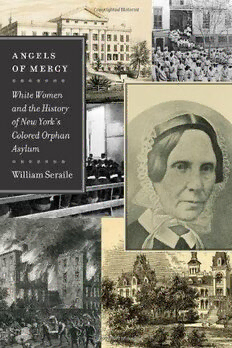
Angels of Mercy: White Women and the History of New York's Colored Orphan Asylum (Empire State Editions) PDF
Preview Angels of Mercy: White Women and the History of New York's Colored Orphan Asylum (Empire State Editions)
Angels of Mercy This page intentionally left blank Angels of Mercy White Women and the History of New York’s Colored Orphan Asylum (cid:23) (cid:23) (cid:71)(cid:88)(cid:107)(cid:105)(cid:96)(cid:90)(cid:96)(cid:88)(cid:23)(cid:66)(cid:102)(cid:99)(cid:99)(cid:88)(cid:101)(cid:91)(cid:92)(cid:105)(cid:23)(cid:110)(cid:96)(cid:107)(cid:95)(cid:23)(cid:65)W(cid:102)(cid:95)il(cid:101)li(cid:23)(cid:70)am(cid:203)(cid:74) (cid:108)S(cid:99)e(cid:99)(cid:96)r(cid:109)a(cid:88)il(cid:101)e Empire State Editions An imprint of Fordham University Press New York 2011 Copyright(cid:2)2011FordhamUniversityPress Allrightsreserved.Nopartofthispublicationmaybereproduced,storedinaretrieval system,ortransmittedinanyformorbyanymeans—electronic,mechanical, photocopy,recording,oranyother—exceptforbriefquotationsinprintedreviews, withoutthepriorpermissionofthepublisher. FordhamUniversityPresshasnoresponsibilityforthepersistenceoraccuracyofURLs forexternalorthird-partyInternetwebsitesreferredtointhispublicationanddoesnot guaranteethatanycontentonsuchwebsitesis,orwillremain,accurateorappropriate. FordhamUniversityPressalsopublishesitsbooksinavarietyofelectronicformats. Somecontentthatappearsinprintmaynotbeavailableinelectronicbooks. LibraryofCongressCataloging-in-PublicationData Seraile,William,1941– Angelsofmercy:whitewomenandthehistoryofNewYork’sColoredOrphan Asylum/WilliamSeraile.—1sted. p. cm. Includesbibliographicalreferencesandindex. ISBN978-0-8232-3419-6(cloth:alk.paper) 1.ColoredOrphanAsylumandAssociationfortheBenefitofColoredOrphans(New York,N.Y.)—History. 2.Womenphilanthropists—NewYork(State)—NewYork— History. 3.Women,White—NewYork(State)—NewYork—History. I.Title. HV995.N52C657 2011 362.73(cid:2)2—dc22 2011006835 PrintedintheUnitedStatesofAmerica 13 12 11 5 4 3 2 1 Firstedition Contents Preface vii Acknowledgments xi Introduction 1 1. TheEarlyYears,1836–42 8 2. FifthAvenue:GrowthandProgress,1843–54 31 3. DisasterandRebirth,1855–63 54 4. Harlem,1864–83 76 5. Harlem,1884–1906 97 6. NewStartinRiverdale,1907–22 120 7. Riverdale:TrialsandTribulations,1923–36 158 8. FromtheColoredOrphanAsylumtotheRiverdale Children’sAssociation,1937–46 178 Conclusion 209 Appendixes A. FoundersoftheColoredOrphanAsylum,1836 213 B. OriginalMaleAdviserstotheCOA,1836–37 213 vi | contents C. EarlyCOAMajorFinancialSupportersinthe1830s 214 D. COAManagers/Trustees,1837–1946 216 E. FirstDirectress/President 232 F. Superintendent/ExecutiveDirector 232 G. LocationsoftheCOA’sHomes 233 Notes 235 Bibliography 265 Index 273 Preface The Colored Orphan Asylum, founded in New York City in 1836, is a remarkable institution that is still in the forefront aiding children. Althoughnolongeranorphanage,itssuccessor,theHarlemDowling– WestSideCenterforChildrenandFamilyServices,maintainstheprin- ciples ofthewomenwhoorganizednearlytwohundredyearsagothe firstorphanageforchildrenofAfricandescentintheUnitedStates. Remarkably, the twenty-five founders fought against gender dis- crimination, financial difficulties, and initial black resistance to house childrenwhowereeitherneglected,mistreated,ororphaned.Manyof the women were the daughters, wives, or siblings of influential New Yorkerswhomadetheirreputation andwealthasbusinessmen,bank- ers, merchants, or entrepreneurs. Some were ardently antislavery, if notabolitionists. This study has several major themes that will be explored in its eight chapters. First, I will describe the efforts of the white women managers to procure a home for the children despite intense racial hostilityandgeneralcivicdisinterest.Althoughtheywouldeventually receive financial backing from some of Manhattan’s wealthiest citi- zens, including John Jacob Astor, Rufus Lord, Gerrit Smith, Gulian C. Verplanck, John Horsburg, Anson G. Phelps, Ann Jay, and Elizabeth and Sarah DeMilt, to name a few, the early years of the orphanage representedafinancialnightmare. Second, while the white female managers and their male advisers were dedicated touplifting theblackchild, theyharboredextreme pa- ternalisticviewsthatdidnotseekguidancefromtheAfricanAmerican community.Theexception,ofcourse,wasthehiringofJamesMcCune viii | preface Smith as the institution’s physician, a position he held for twenty years. The orphanage accepted material aid in the form of nonperish- ablegoods,volunteerlabor,andsmallfinancialcontributionsfromthe blackcommunity,butitdidnotseektheiradviceandonlygrudgingly accepteditwhenitwasgiven. Third, the evangelical and mainly Quaker founding managers sought to save the souls of their charges. Later, in the nineteenth cen- tury, their successors adopted a harsher, moralistic tone as they (and othersimilarinstitutions)becamemorebureaucraticandprofessional. Their objective was to uplift the poor in their care and, in a sense, to ‘‘rescue’’ their charges not only from the evils of the street but also from the perception that they, and not the black community, could bestraisethechildrenintoresponsibleadulthood. Fourth,itwasfrankcriticismin1913fromW.E.B.DuBois,editor ofThe Crisis,that highlightedtheconflict betweentheorphanage and the community it served. It was not until 1939 that the white leader- ship decided that it was not enough simply to employ African Ameri- cans inmenial positions; theyalso had toreach out andinclude them intheleadershipoftheinstitution.Theorphanage’sfirstblackfemale trustee was elected in that year and was soon followed by others, in- cludingJewishwomenandAfricanAmericanmen. Fifth, it had become clear in the first few decades of the twentieth century that the institution was an orphanage primarily in name, as mostofthechildrenundercarewere‘‘half-orphans,’’thatis,neglected ordelinquentchildren.Itwasduringthisperiodthatthetrusteesintro- duced the cottage system as a means to accommodate children in a less-institutionalizedmanner.Boardingthechildrenoutledtoagreater interaction with black churches and families. An antidiscrimination lawinNewYorkStatepressuredthereluctanttrusteestoacceptwhite children in the late 1940s. It was at this time that it was decided to close the ‘‘orphanage’’ in the Riverdale section of the Bronx and find boardinghomesforallthechildren. The Colored Orphan Asylum survived several fires, the nation’s financialpanics,wars,theGreatDepression,andracialhostilitysoviru- lentthatitledtothedestructionofitsFifthAvenuebuildingbyamob duringNewYork’sJuly1863draftriots.Overfifteenthousandchildren preface | ix were raised in the orphanage during the period under study, and throughoutitshistory,lettersandvisitshaverevealedthathundredsif not thousands of ‘‘old boys and girls’’ have looked back with admira- tion and respect for the home that nurtured them throughout their formativeyears.
